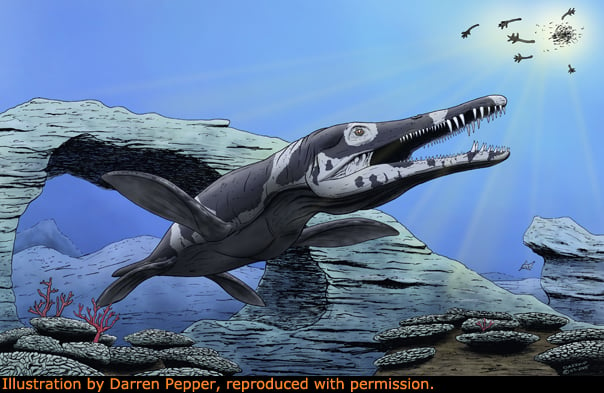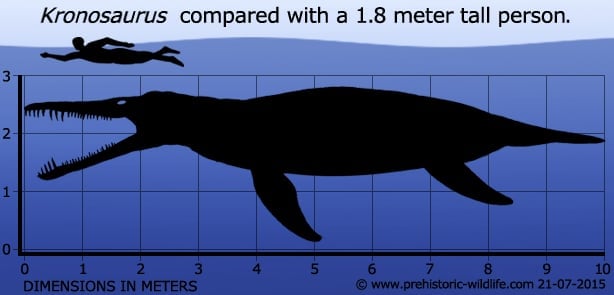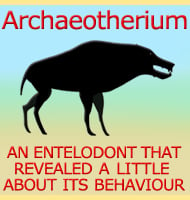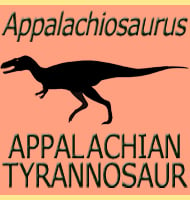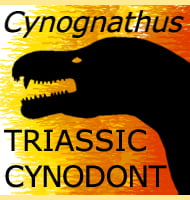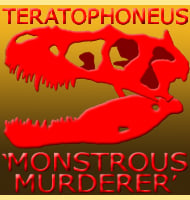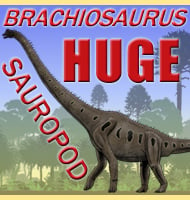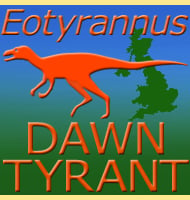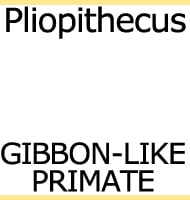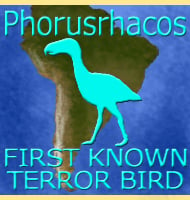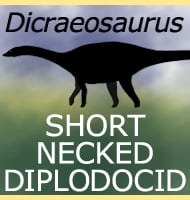In Depth
Kronosaurus is one of the more famous fossil discoveries to come from Australia, and as a huge short-necked pliosaur, Kronosaurus would have been an apex predator of the waters it swam in. The teeth of Kronosaurus are conical and up to thirty centimetres long, although most of that was root with up to twelve centimetres making up the exposed crown. Interestingly the teeth of Kronosaurus are quite different to other pliosaurs in that they are not serrated and do not have three facets. The teeth may suggest that despite its large size Kronosaurus may have seized smaller to medium sized prey which could then be manipulated to be swallowed. The only way that Kronosaurus could have fed from larger prey would be to clamp on with its jaws and then use brute strength from its body to tear off a chunk of flesh by twisting or rolling. Either way it seems that Kronosaurus may have eaten in a similar manner to a crocodile.
One prey type for Kronosaurus seems to have been the long necked elasmosaurid plesiosaurs that were quite common in the southern oceans of the Cretaceous. Evidence for this predation comes from the skull of an Eromangasaurus that seems to have Kronosaurus bite marks. Also the fact that Eromangasaurus is only known from a skull might suggest that the head was torn off in the Kronosaurus attack. Initial size estimates for Kronosaurus placed it at just under thirteen meters long. However further study combined with a better understanding of pliosaur remains in general resulted in a reduction in this estimate to somewhere in the region of nine to ten meters long. This estimate is universally accepted as being more accurate, and although the upper size is reduced to ten meters, Kronosaurus was still big for a pliosaur and was much bigger than Liopleurodon which is often incorrectly credited as the biggest pliosaur ever. An even bigger pliosaur than Kronosaurus however is the one that has been dubbed ‘Predator X’, which is now classified as a species of Pliosaurus. A former species of Kronosaurus, K. boyacensis, was redescribed as a distinct genus Monquirasaurus, in 2021. The same study also proposed moving most of the known fossils of Kronosaurus with the exception of the holotype to a new genus called Eiectus.
Further Reading
– Some Queensland fossil vertebrates. – Memoirs of the Queensland Museum 7(1):16-25. – H. A. Longman – 1924. – Ein gro�w�chsiger Pliosauride (Reptilia: Plesiosauria) aus der Unterkreide (oberes Aptium) von Kolumbien. – Courier Forschungsinstitut Senckenberg 145:1-25. – O. Hampe – 1992. – Cretaceous marine reptiles of Australia: a review of taxonomy and distribution. – Cretaceous Research 24: 277–303. – B. P. Kear – 2003. – Giant pliosaurids (Sauropterygia; Plesiosauria) from the Lower Cretaceous peri-Gondwanan seas of Colombia and Australia. – Cretaceous Research. 132 – Leslie F.No� & MarcelaG�mez-P�rez – 2021.
